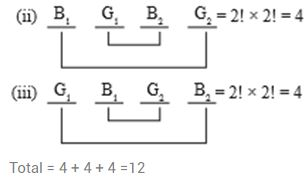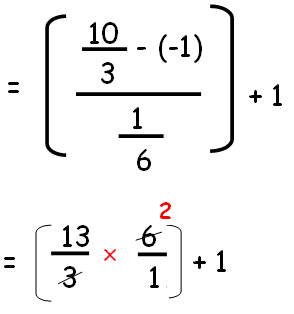- Home
- Prelims
- Mains
- Current Affairs
- Study Materials
- Test Series
 EDITORIALS & ARTICLES
EDITORIALS & ARTICLES
April 22, 2021 - CSAT Quiz
1. P works thrice as fast as Q, whereas P and Q together can work four times as fast as R. If P, Q and R together work on a job, in what ratio should they share the earnings?
(a) 3 : 1 : 1
(b) 3 : 2 : 4
(c) 4 : 3 : 4
(d) 3 : 1 : 4
Solution:
P : Q = 3 : 1
(P + Q) : R = 4 : 1 = (3 + 1) : 1
P : Q : R = 3 : 1 : 1
(a) 3 : 1 : 1
[Note: If A can work x times faster than B, then A’s share of work shall be x/(x+1)th part of the total work]
2. Consider the following relationships among members of a family of six persons A, B, C, D, E and F:

 Hence the answer is option (c):
(c) 12
5. How many of the three-digit numbers are divisible by 7?
(a) 108
(b) 116
(c) 124
(d) 128
Solution:
Arithmetic Progression
Find the total number of terms in an arithmetic sequence
By using the formula
n = [(L- a)/d] + 1
we can find the total number of terms of an arithmetic sequence.
L - Last term
a = first term
d = common difference (a2 - a1)
Example
How many terms are there in the following Arithmetic progressions ?
-1,-5/6,-2/3,……………10/3
Solution :
First term (a) = -1
Common difference (d) = a2 – a1
d = (-5/6) – (-1)
d = 1/6
n = [(L-a)/d] + 1
L = 10/3
Hence the answer is option (c):
(c) 12
5. How many of the three-digit numbers are divisible by 7?
(a) 108
(b) 116
(c) 124
(d) 128
Solution:
Arithmetic Progression
Find the total number of terms in an arithmetic sequence
By using the formula
n = [(L- a)/d] + 1
we can find the total number of terms of an arithmetic sequence.
L - Last term
a = first term
d = common difference (a2 - a1)
Example
How many terms are there in the following Arithmetic progressions ?
-1,-5/6,-2/3,……………10/3
Solution :
First term (a) = -1
Common difference (d) = a2 – a1
d = (-5/6) – (-1)
d = 1/6
n = [(L-a)/d] + 1
L = 10/3
 n = 27
Hence, 27 terms are in the given A.P
The minimum three digit number divisible by 7 is 105 and maximum number is 994.
Hence, a=105,d=7,L=994
L=a+(n-1)d;
994=105+(n-1)7
by solving,we get
n=128.
[OR]
The number of multiples of x in the range= ( [Last multiple of x in the range − First multiple of x in the range] / x )
+1
Last 3-digit multiple of 7 is 994;
First 3-digit multiple of 7 is 105;
So the number of 3-digt multiples of 7 is [(994−105)7]+1=128
(d) 128
n = 27
Hence, 27 terms are in the given A.P
The minimum three digit number divisible by 7 is 105 and maximum number is 994.
Hence, a=105,d=7,L=994
L=a+(n-1)d;
994=105+(n-1)7
by solving,we get
n=128.
[OR]
The number of multiples of x in the range= ( [Last multiple of x in the range − First multiple of x in the range] / x )
+1
Last 3-digit multiple of 7 is 994;
First 3-digit multiple of 7 is 105;
So the number of 3-digt multiples of 7 is [(994−105)7]+1=128
(d) 128
- The number of males equals that of females.
- A and E are sons of F.
- D is the mother of two, one boy and one girl.
- B is the son of A.
- There is only one married couple in the family at present.

 Hence the answer is option (c):
(c) 12
5. How many of the three-digit numbers are divisible by 7?
(a) 108
(b) 116
(c) 124
(d) 128
Solution:
Arithmetic Progression
Find the total number of terms in an arithmetic sequence
By using the formula
n = [(L- a)/d] + 1
we can find the total number of terms of an arithmetic sequence.
L - Last term
a = first term
d = common difference (a2 - a1)
Example
How many terms are there in the following Arithmetic progressions ?
-1,-5/6,-2/3,……………10/3
Solution :
First term (a) = -1
Common difference (d) = a2 – a1
d = (-5/6) – (-1)
d = 1/6
n = [(L-a)/d] + 1
L = 10/3
Hence the answer is option (c):
(c) 12
5. How many of the three-digit numbers are divisible by 7?
(a) 108
(b) 116
(c) 124
(d) 128
Solution:
Arithmetic Progression
Find the total number of terms in an arithmetic sequence
By using the formula
n = [(L- a)/d] + 1
we can find the total number of terms of an arithmetic sequence.
L - Last term
a = first term
d = common difference (a2 - a1)
Example
How many terms are there in the following Arithmetic progressions ?
-1,-5/6,-2/3,……………10/3
Solution :
First term (a) = -1
Common difference (d) = a2 – a1
d = (-5/6) – (-1)
d = 1/6
n = [(L-a)/d] + 1
L = 10/3
 n = 27
Hence, 27 terms are in the given A.P
The minimum three digit number divisible by 7 is 105 and maximum number is 994.
Hence, a=105,d=7,L=994
L=a+(n-1)d;
994=105+(n-1)7
by solving,we get
n=128.
[OR]
The number of multiples of x in the range= ( [Last multiple of x in the range − First multiple of x in the range] / x )
+1
Last 3-digit multiple of 7 is 994;
First 3-digit multiple of 7 is 105;
So the number of 3-digt multiples of 7 is [(994−105)7]+1=128
(d) 128
n = 27
Hence, 27 terms are in the given A.P
The minimum three digit number divisible by 7 is 105 and maximum number is 994.
Hence, a=105,d=7,L=994
L=a+(n-1)d;
994=105+(n-1)7
by solving,we get
n=128.
[OR]
The number of multiples of x in the range= ( [Last multiple of x in the range − First multiple of x in the range] / x )
+1
Last 3-digit multiple of 7 is 994;
First 3-digit multiple of 7 is 105;
So the number of 3-digt multiples of 7 is [(994−105)7]+1=128
(d) 128









 Latest News
Latest News General Studies
General Studies